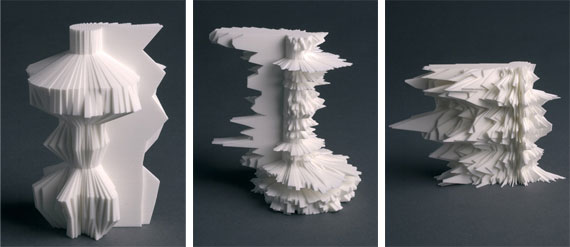
Andy Huntington/ Drew Allan: Cylinder (”Seahorses”, “Designed”, “Market”)
Cylinder by Andy Huntington and Drew Allan is an elegant series of data sculpture based on sound analysis. A mapping of the frequency and time domains produces cylindrical forms representing the spatial characteristics of the sound input. Physical versions of the digital 3D models are then 3D printed using stereolithography.
The idea of mapping sound to space is not unfamiliar. The Cylinder project shows similar strategies to those used in the exhibition Frozen, which showed sound represented as a continous space rather than as a one-dimensional signal. However, Cylinder is from 2003, predating Frozen and making it somewhat of an early example of the data sculpture genre.
There is a tangential similarity between Huntington’s pristine objects and Booshan & Widrig’s Binaural object. But in fact the spiky geometries of both works are a result of the numeric data underlying the form. Any data set will yield inherent patterns, and in the case of digital sound two “defaults” present themselves: The waveform (a 1D graph) and the spectral map found through FFT analysis, which represents a 2D map of spectral energies in the time domain. Any translation of these numeric representations into visual form must grapple with the fact that while they may be faithful representations of the data, they rarely give a good idea of how the sound is experienced by a human listener.
The Cylinder series show a range of different waveforms, some showing an apparent orderly structure with others suggesting a noisier sound input. Titles like “Seahorse”, “Design” and “Breath” imply the source sounds used to produce the forms. Their success as aesthetic objects derive from their complexity as well as from the clean quality given by the 3D printing process.
-----
Via Generator.x


